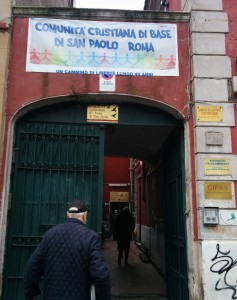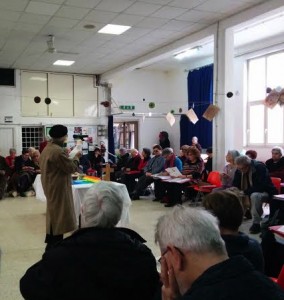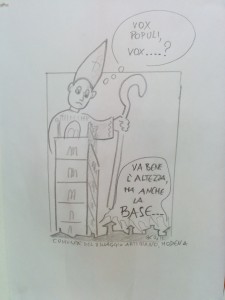Base communities and the invisible

Over the weekend I attended a planning meeting with international partners to clarify the goals of an event to mark the 50th anniversary of the closing of Vatican II, to be held in the fall of 2015 in Rome. A dozen or so organizers from around the world united under the theme of “making visible what has been made invisible.” Lifting up the imagery of the Catacombs, many felt that the People of God have been hidden (or ignored) in the catacombs for several decades, and now, more than ever, must come into the fresh air. The “Council 50” meeting is still evolving in its form, but its core intention seems to be highlighting how communities are being Church, both inspired by Vatican II, and in response to the shortcomings of Vatican II.
During our meeting we took a drive across town to the San Paolo Base Community, one of four “Basic Christian Communities” in Rome. From their founding documents, they are “engaged in overcoming the contradiction between the Spirit of the Gospel, and the practice of the Roman Catholic institution.” These communities formed organically in the 1960s and 70s throughout Latin America and Italy “not to create another Church,” but to help include “the other” in the Roman Catholic Church.
In Italy, the Basic Community of St. Paul began first at the Basilica of St. Paul Outside the Walls, where Giovanni Franzoni was the abbot at the time. Franzoni, born in 1928 was present for our celebration on Sunday, and signing copies of his latest book, “Autobiografia di un cattolico marginale.” Peace activist, communist, and outspoken against the Church’s teachings on divorce, it was reported that Franzoni’s “attitudes caused and continue to cause profound disturbance among the people of God.” Franzoni was defrocked by Pope Paul VI in 1976 after sustained theological feuds, and reportedly for his intention to vote for the Italian Communist Party.
 We celebrated mass on Sunday in a circle, with a shared homily, shared consecration, and shared announcements. During the last conclave, Women’s Ordination Worldwide members celebrated mass at this base community, with womenpriest Janice Sevre-Duszynska, but as it was on a Tuesday afternoon, many of the community members did not attend; it was heartening to see a full circle this time. The community was welcoming and gracious, and sang African American spirituals in English for our benefit. It was a beautiful gathering, unlike any I’ve attended in Rome.
We celebrated mass on Sunday in a circle, with a shared homily, shared consecration, and shared announcements. During the last conclave, Women’s Ordination Worldwide members celebrated mass at this base community, with womenpriest Janice Sevre-Duszynska, but as it was on a Tuesday afternoon, many of the community members did not attend; it was heartening to see a full circle this time. The community was welcoming and gracious, and sang African American spirituals in English for our benefit. It was a beautiful gathering, unlike any I’ve attended in Rome.
However, a familiar uneasiness filled this circle of “progressive Catholics,” certainly criticisms we’ve all heard (and uttered) before. During the shared homily only one woman got up to speak, our own Martha Heizer, coordinator for the International Movement: We Are Church, from Austria. She spoke alongside a man from our group who translated her thanks for the hospitality we received at S. Paolo. Interestingly, during the announcements only women spoke, holding up their agendas and diaries, sharing the coming week’s events. Perhaps too obvious to even mention, I was the youngest person in the circle, with no peers even a decade in either direction.

And so when we went back to our meeting to discuss elevating the traditions in the catacombs, I had to wonder if we even have the proper lighting, the proper lenses to see what is invisible (and what we choose not to see). Even with the best intentions few are called to make the uncomfortable journey, the unfamiliar journey to way of Church (or life) that we do not know. The barriers are physical, spatial, political, emotional, …. the list goes on, but most of all challenging. The discussion of how to “add diversity” to a conference must not only be about creating a safe, accessible space but moreover, giving up one’s own seat. I pray that the Council 50 meeting reaches communities we do not know yet, and people we have not met yet. I take heart that we have the example of Jesus, who consciously crossed barriers to be with “the others” with love. May this inspire new ways of being Church and being personal and structural/institutional allies. The S. Paolo community and so many grassroots, small faith communities begin with like-minded friends, fulfilling common spiritual needs. I hope that knowing that many, many of the People of God have been othered by the hierarchy we can all begin to see, hear, and welcome the needs of others, and other others. Many of whom I know are in our communities currently, quietly holding their “catacombed” needs.
Further Reading:
8 Ways Not to be An Ally, Not a Comprehensive List, Black Girl Dangerous
Walking Across the Room, Training For Change (and more tools from Training for Change)
A Nun’s Secret Ministry Brings Hope to the Transgendered Community, Aljazzera America
Understanding Grace, a project from the American Anthropological Association
… add your own recommended reading links in the comments!
